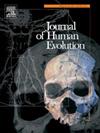尼安德特人长距离迁移:埃尔卡斯蒂略洞穴(西班牙北部)和“瓦斯科尼”莫斯特人的案例
IF 3.1
1区 地球科学
Q1 ANTHROPOLOGY
引用次数: 0
摘要
这项研究探索了位于伊比利亚半岛北部的El Castillo洞穴中尼安德特人的流动性和原材料流通,特别关注了燧石。分析的水平(XXab-XXf1.1)在45 - 70 ka BP之间,对应于莫斯特期,在某些情况下对应于瓦斯纪相。大多数燧石品种来自当地(10-30公里),但已经确定了另外六个来源,包括区域性(30-120公里)和示踪剂(120-250公里),以及一个属于超级示踪剂范围(250公里)的品种。这些发现提供了对岩石资源获取模式的见解。根据这些数据,再加上技术类型学数据和不同种类原材料的定量表征,我们提出,这些尼安德特人的领土比预期的要大。在他们的家园范围之外,他们可能有一个更大的“社会领土”,覆盖超过600公里的长度,从奥维耶多盆地(Piedramuelle燧石)到阿杜尔河(Tercis燧石),包括上埃布罗盆地(Treviño燧石)。此外,这一广阔的地理区域和El Castillo地层的日期与Mousterian与cleavers或Vasconian的空间分布一致。对这些组合的技术类型学分析表明,瓦斯科尼期可能与该群体的广泛视野和思想共享更密切相关,而不是代表严格定义的技术传统。本文章由计算机程序翻译,如有差异,请以英文原文为准。
Neanderthal mobility over very long distances: The case of El Castillo cave (northern Spain) and the ‘Vasconian’ Mousterian
This study explores the mobility and raw material circulation of Neanderthals at the El Castillo cave, located in the northern part of the Iberian Peninsula, with a particular focus on flint. The levels analyzed (XXab–XXf1.1) date between 45 and 70 ka BP, corresponding to the Mousterian period and, in some cases, to the Vasconian facies. Most of the flint varieties are of local origin (<10–30 km), but six additional sources have been identified, both regionally (30–120 km) and tracer (120–250 km), as well as a variety that would fall under the supertracer range (>250 km). These findings provide insights into patterns of lithic resource acquisition. Based on these data, together with the technotypological data and the quantitative representation of the different varieties of raw materials, it is proposed that the territory of these Neanderthals was larger than expected. Beyond their home range, they may have had an even larger ‘social territory,’ covering more than 600 km in length, from the Oviedo basin (Piedramuelle flint) to the Adour River (Tercis flint), including the Upper Ebro Basin (Treviño flint). Furthermore, this broad geographical region and the dates from the levels at El Castillo align with the spatial distribution of the Mousterian with cleavers or the Vasconian. The technotypological analysis of these assemblages suggests that the Vasconian may be more closely related to a broad view of the group and the sharing of ideas, rather than representing a strictly defined technological tradition.
求助全文
通过发布文献求助,成功后即可免费获取论文全文。
去求助
来源期刊

Journal of Human Evolution
生物-进化生物学
CiteScore
6.30
自引率
15.60%
发文量
104
审稿时长
3 months
期刊介绍:
The Journal of Human Evolution concentrates on publishing the highest quality papers covering all aspects of human evolution. The central focus is aimed jointly at paleoanthropological work, covering human and primate fossils, and at comparative studies of living species, including both morphological and molecular evidence. These include descriptions of new discoveries, interpretative analyses of new and previously described material, and assessments of the phylogeny and paleobiology of primate species. Submissions should address issues and questions of broad interest in paleoanthropology.
 求助内容:
求助内容: 应助结果提醒方式:
应助结果提醒方式:


